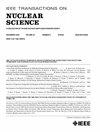超低损耗光纤辐射响应的温度依赖性:自困孔的作用
IF 1.9
3区 工程技术
Q3 ENGINEERING, ELECTRICAL & ELECTRONIC
引用次数: 0
摘要
研究了超低损耗纯硅芯(PSC)单模光纤(of)在可见光(VIS)到红外(IR)光谱域x射线辐射诱导衰减(RIA)的温度($- 60~^{\circ}$ C, $20~^{\circ}$ C和$100~^{\circ}$ C)的依赖关系。该光纤在整个光谱域具有极高的RIA水平,在室温下具有非常高的辐射敏感性。RIA水平和动力学表现出强烈的依赖于辐照温度。讨论了光纤发黑源处辐射致点缺陷的性质和特性,特别讨论了自困孔(STHs)的不同变体对其的影响。与最先进的抗辐射OFs一样,STHs在这类OFs的响应中起着关键作用。本文章由计算机程序翻译,如有差异,请以英文原文为准。
Temperature Dependence of the Radiation Response of Ultralow-Loss Optical Fibers: Role of Self-Trapped Holes
We investigated the temperature ( $- 60~^{\circ }$ C, $20~^{\circ }$ C, and $100~^{\circ }$ C) dependence of the X-ray radiation-induced attenuation (RIA) in the visible (VIS) to infrared (IR) spectral domain of an ultralow-loss (ULL) pure-silica core (PSC) single-mode optical fiber (OF). This fiber was shown to be very radiation-sensitive at room temperature (RT) with extremely high RIA levels in the whole spectral domain. The RIA levels and kinetics exhibit a strong dependence on the temperature of irradiation. The nature and the properties of the radiation-induced point defects at the origin of the fiber darkening are discussed, in particular, the influence of the different variants of the self-trapped holes (STHs). STHs play a key role in the response of this class of OF as in the ones of the most advanced radiation-hardened OFs.
求助全文
通过发布文献求助,成功后即可免费获取论文全文。
去求助
来源期刊

IEEE Transactions on Nuclear Science
工程技术-工程:电子与电气
CiteScore
3.70
自引率
27.80%
发文量
314
审稿时长
6.2 months
期刊介绍:
The IEEE Transactions on Nuclear Science is a publication of the IEEE Nuclear and Plasma Sciences Society. It is viewed as the primary source of technical information in many of the areas it covers. As judged by JCR impact factor, TNS consistently ranks in the top five journals in the category of Nuclear Science & Technology. It has one of the higher immediacy indices, indicating that the information it publishes is viewed as timely, and has a relatively long citation half-life, indicating that the published information also is viewed as valuable for a number of years.
The IEEE Transactions on Nuclear Science is published bimonthly. Its scope includes all aspects of the theory and application of nuclear science and engineering. It focuses on instrumentation for the detection and measurement of ionizing radiation; particle accelerators and their controls; nuclear medicine and its application; effects of radiation on materials, components, and systems; reactor instrumentation and controls; and measurement of radiation in space.
 求助内容:
求助内容: 应助结果提醒方式:
应助结果提醒方式:


